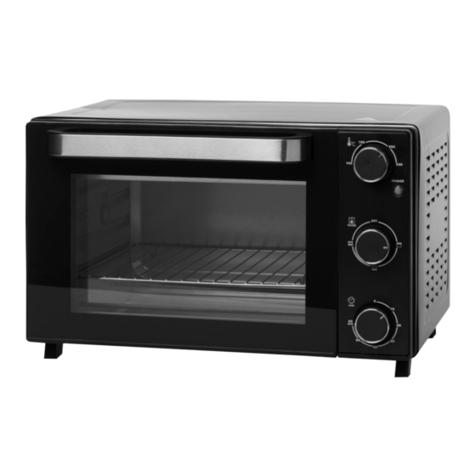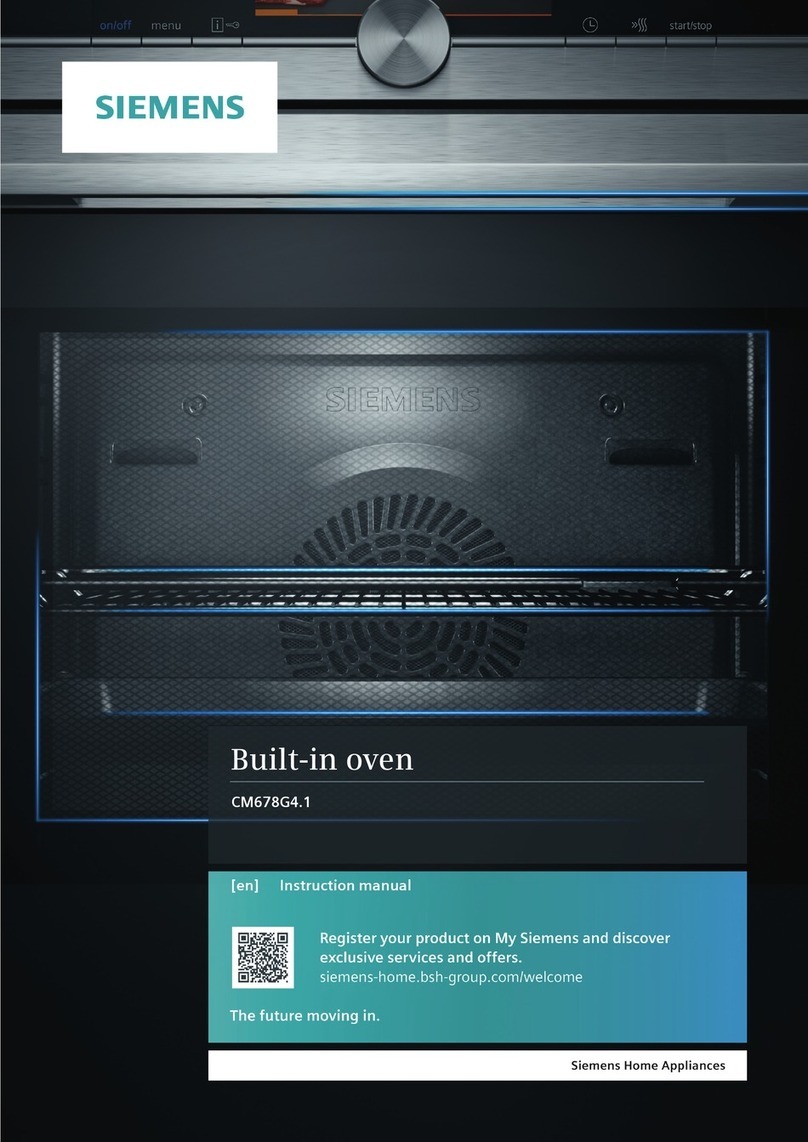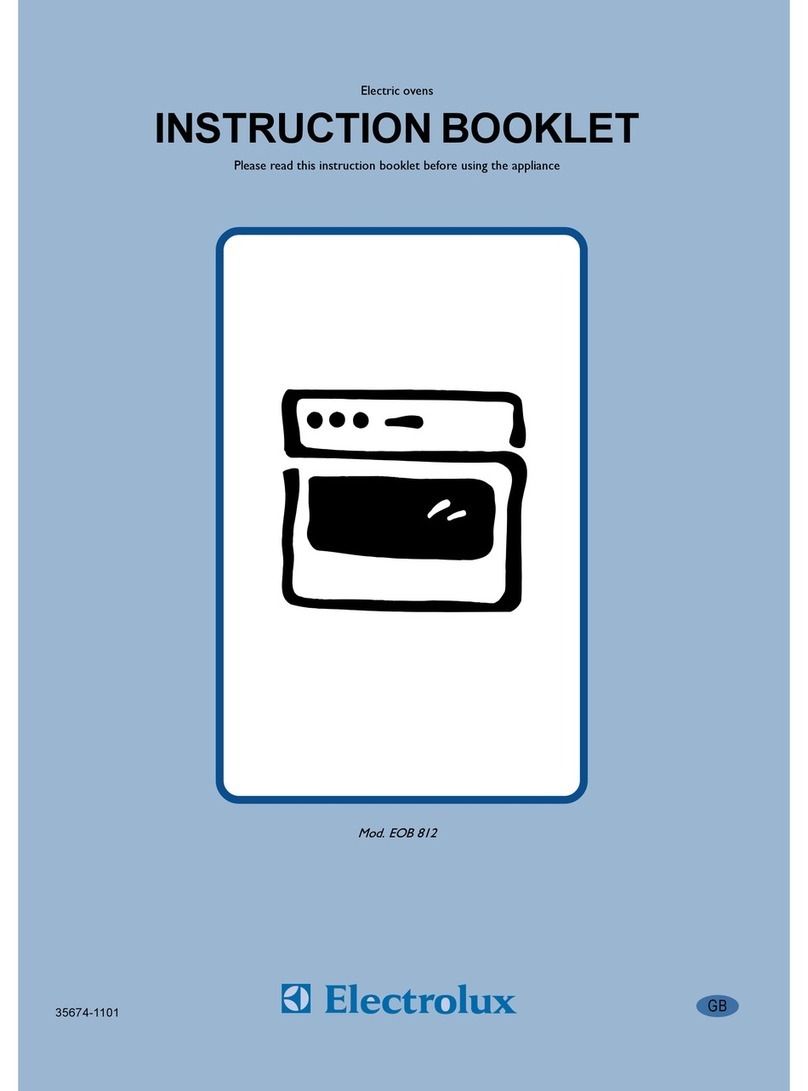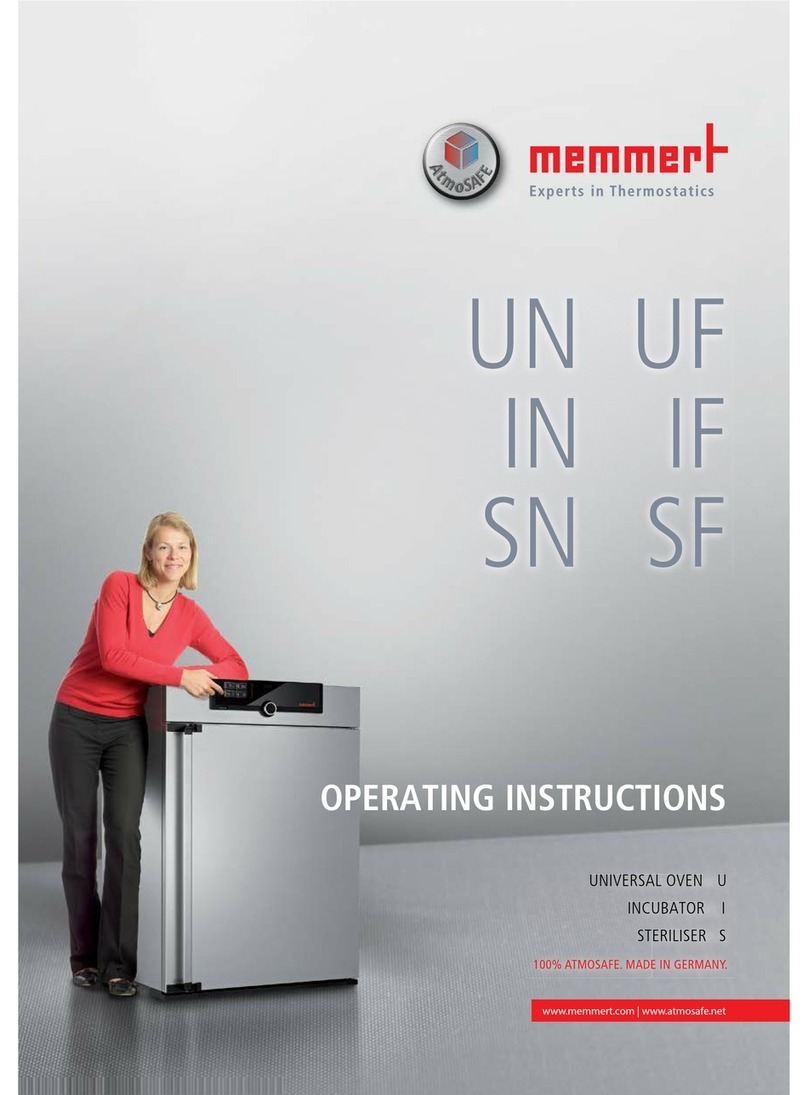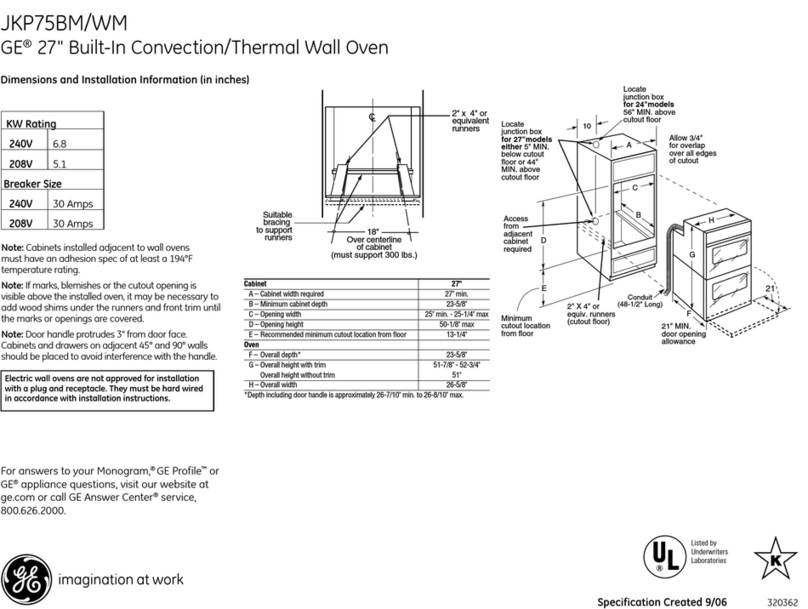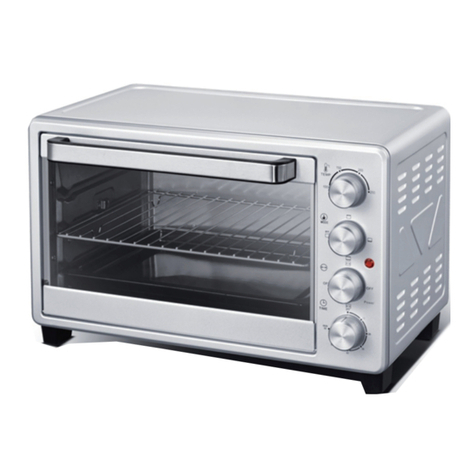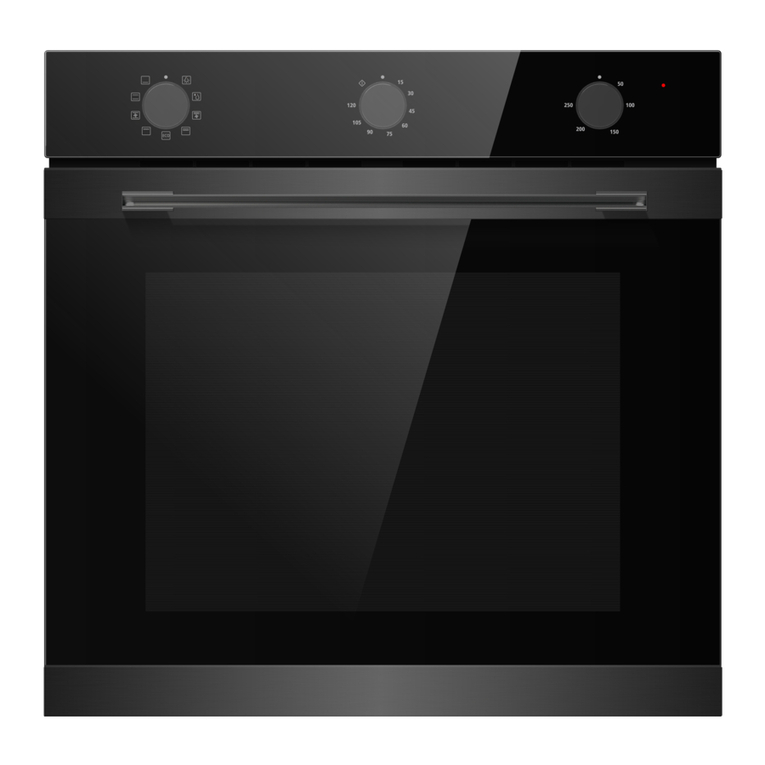M-system MIO670 Technical manual

PYROLYTIC
OVENS
Instruction for the use - Installation advice
KEEP IN A SAFE PLACE
Before operating this oven, please read these instructions carefully

2
Dear Customer,
Thank you for having purchased and given your pref-
erence to our product.
The safety precautions and recommendations within this
booklet are for your own safety and that of others. They
will also provide a means by which to make full use of
the features offered by your appliance.
Please preserve this booklet carefully. It may be useful
in future, either to yourself or to others in the event that
doubts should arise relating to its operation.
This appliance must be used only for the task it has
explicitly been designed for, that is for cooking food-
stuffs. Any other form of usage is to be considered as
inappropriate and therefore dangerous.
The manufacturer declines all responsibility in the
event of damage caused by improper, incorrect or illog-
ical use of the appliance.

3
IMPORTANT PRECAUTIONS AND RECOMMENDATIONS
– After having unpacked the appliance, check to ensure that it is not damaged.
If you have any doubts, do not use it and contact the store from where you
purchased it.
– Packing materials (i.e. plastic bags, polystyrene foam, nails, packing straps, etc.)
should not be left around within easy reach of children, as these may cause serious
injuries.
– Do not attempt to modify the technical characteristics of the appliance as it may
become dangerous to use.
– Never cover the oven walls with aluminium foil. Do not put baking sheets or the drip
tray on the bottom of the oven.
– Do not carry out cleaning or maintenance operations on the appliance without having
previously disconnected it from the electric power supply.
– If you should decide not to use this appliance any longer (or decide to substitute an
older model), before disposing of it, it is recommended that it be made inoperative in
an appropriate manner in accordance to health and environmental protection regula-
tions, ensuring in particular that all potentially hazardous parts be made harmless,
especially in relation to children who could play with old appliances.
IMPORTANT PRECAUTIONS AND RECOMMENDATIONS FOR USE OF ELECTRICAL
APPLIANCES
Use of any electrical appliance implies the necessity to follow a series of fundamental
rules. In particular:
– Never touch the appliance with wet hands or feet;
– do not operate the appliance barefooted;
– do not allow children or disabled people to use the appliance without your supervision.
The manufacturer cannot be held responsible for any damages caused by improper,
incorrect or unreasonable use of the appliance.
DECLARATION OF
CE
CONFORMITY
– This oven has been designed to be used only for cooking. Any other use (such as
heating a room) is improper and dangerous.
– This oven has been designed, constructed, and marketed in compliance with:
- safety requirements of EEC Directive “Low voltage” 73/23
- safety requirements of EEC Directive “EMC” 89/336;
- requirements of EEC Directive 93/68.

4
Control panel
A
U
T
O
P
°CF
0
°C
PP
1 32
Fig. 1.1
4
Multifunction oven with “fan grill cooking” function
65
A
U
T
O
P
0
F
°C
PP
1 2
Fig. 1.2
6
Multifunction oven with “fan grill cooking”function
5
A
U
T
O
P
0
°CF
°C
PP
1 32
Fig. 1.3
4
Multifunction oven with “grill cooking with turnspit”function
65
A
U
T
O
P
0
F
°C
PP
1 2
Fig. 1.4
6
Multifunction oven with “grill cooking with turnspit”function
5
MULTIFUNCTION PYROLYTIC OVENS
1

5
DESCRIPTION OF COMMANDS
1. Function selector knob
2. Electronic programmer
3. Temperature knob (potentiometer)
4. Line pilot light
5. Door locked pilot light
6. Temperature pilot light
A
U
T
O
P
0
°CF
°C
PP
1 32
Fig. 1.5
4
Plurifunction oven with “fan grill cooking”function
65
A
U
T
O
P
0
F
°C
PP
1 2
Fig. 1.6
6
Plurifunction oven with “fan grill cooking”function
5
A
U
T
O
P
0
°CF
°C
PP
1 32
Fig. 1.7
4
Plurifunction oven with “grill cooking with turnspit”function
65
A
U
T
O
P
0
F
°C
PP
1 2
Fig. 1.8
6
Plurifunction oven with “grill cooking with turnspit”function
5
PLURIFUNCTION PYROLYTIC OVENS

6
TECHNICAL FEATURES
This oven has special operating features.
5 different functions can be used to satisfy all cooking needs; it also has a pyrolytic
function which can clean the oven cavity at high temperature, a defrost function and
an oven light function.
The functions are managed by an electronic programmer which keeps the temperature
set constant by means of a probe inside the oven cavity.
The oven has the following heating elements:
• Lower heating element (double) 500+1300 W
• Upper heating element 1000 W
• Grill heating element 2000 W
• Circular heating element 2200 W (only in multifunction pyrolytic ovens)
WARNING:
The door is hot, use the handle.
During use the appliance becomes hot. Care should be taken to avoid touching heating
elements inside the oven.
How to use the pyrolytic oven 2
A cooling fan starts automatically when the temperature inside the oven cavity is
higher than 100°C and stops when the temperature drops below 100°C. For the
pyrolytic function only, it starts immediately the pyrolytic cycle starts.
The purpose of this fan is to reduce the temperature inside/outside the appliance.
USING THE OVEN FOR THE FIRST TIME
- Put in the shelves and trays.
- Switch the oven on empty (on a cooking function – NOT PYROLYSIS) at maximum power
for about 2 hours to remove traces of grease and smells from the components.
- When the oven has cooled down and unplugging it, clean the inside of the oven with a
cloth soaked in water and neutral detergent and dry it perfectly.
NOTES ON OVEN WORKING

OPERATING PRINCIPLES
Heating and cooking in the multifunction pyrolytic oven takes place as follows:
•by normal convection
The heat is produced by the upper and lower heating elements.
•by forced convection (only in multifunction pyrolytic ovens)
A fan sucks in the air contained in the oven, which circulates it through the circular
heating element and then forced back into the oven by the fan. Before the hot air is
sucked back again by the fan to repeat the described cycle, it envelops the food in
the oven, provoking a complete and rapid cooking. It is possible to cook several dishes
simultaneously.
•by semi-forced convection (only in plurifunction pyrolytic ovens)
The heat produced by the upper and lower heating elements is distributed throughout
the oven by the fan.
•by radiation
The heat is radiated by the infra red grill element.
•by radiation and fan (only in multifunction or plurifunction pyrolytic ovens
without turnspit)
The radiated heat from the infra red grill element is distributed throughout the oven
by the fan.
•by double radiation and fan
The fan distributes the heat radiated by the grill heating element and the upper heating
element in the oven.
•by ventilation
The food is defrosted by using the fan only function without heat.
•by pyrolysis
The heat produced by the heating elements cleans the internal oven cavity removing
all residue of grease.
THIS IS NOT A COOKING FUNCTION
7
Attention: the oven door becomes very hot during operation.
Keep children away.
Note: The first time the oven is used or after a black-out the
programmer must be started by pressing keys 2 and 3 simul-
taneously. See the chapter on the use of the electronic pro-
grammer.
°C
PP
23
IIIIII
I
I
I
I
I
I
IIIIIIIIII
I
I
I
I
I
I
IIII

8
SELECTING THE FUNCTIONS (fig. 2.1)
DEFROSTING FROZEN FOODS (this is not a cooking function)
Only the fan and the oven lamp switch on.
Defrosting takes place by fan, without heating.
The electronic programmer shows dEF
Recommended for:
To rapidly defrost frozen foods; 1 kilogram requires about one hour.
The defrosting times vary according to the quantity and type of foods to be defrosted.
OVEN LIGHTING
On turning the knob to this position only the oven lamp lights up.
The lamp is always on in all the cooking functions (not for the pyrolysis).
0
F
*Alternative functions depending on
the model of oven purchased
The cooking function is selected by turning the
function selector knob and matching the mark
with the symbol printed on the print.
Fig. 2.1
Important: In all cooking functions the oven
must always be used with the DOOR CLO-
SED.
If the door stays open
“door”appears on the
programmer display and
after five minutes an audi-
ble warning sounds for 30 seconds and
“door”flashes.
To silence the audible warning press any
programmer pushbutton.
NOTE: The heating elements work even with
the door open and this signal just indicates
that energy is being wasted.
IIIIII
I
I
I
I
I
I
IIIIIIIIII
I
I
I
I
I
I
IIII

9
FAN COOKING WITH DOUBLE GRILL
The infrared ray grill, the upper heating element and the fan switch on. The heat is
mainly diffused by radiation and the fan distributes it in the whole oven. The temperature
can be set between 50 and 250°C.
On selecting this function the electronic programmer starts cooking with a pre-heating
time set at 240°C. To vary the temperature see the “Setting the cooking” chapter.
Recommended for:
Meats which are to be cooked at a high temperature but which must remain tender.
Fish remains more tender; turn it once during cooking.
TRADITIONAL CONVECTION COOKING
The upper and lower heating elements switch on.
The heat is diffused by natural convection and the temperature must be set between
50 and 250°C.
On selecting this function the electronic programmer starts cooking with a pre-heating
time set at 200°C. To vary the temperature see the “Setting the cooking” chapter.
Recommended for:
For foods which require the same cooking temperature both internally and externally, i.
e. roasts, spare ribs, meringue, etc.
CONVECTION COOKING WITH FAN (*only in some models)
The upper and lower heating elements and the fan switch on. The heat from the top
and the bottom is diffused by fan convection. The temperature can be set between 50
and 250°C.
On selecting this function the electronic programmer starts cooking with a pre-heating
time set at 180°C. To vary the temperature see the “Setting the cooking” chapter.
Recommended for:
For foods of large volume and quantity which require the same internal and external
degree of cooking; for ex: rolled roasts, turkey, legs, cakes, etc.
HOT AIR COOKING (*only in some models)
The circular heating element and the fan switch on. The heat is diffused by forced con-
vection and the temperature can be set between 50 and 250°C.
On selecting this function the electronic programmer starts cooking with a pre-heating
time set at 180°C. To vary the temperature see the “Setting the cooking” chapter.
Recommended for:
For foods that must be well done on the outside and tender or rare on the inside, i. e.
lasagna, lamb, roast beef, whole fish, etc.

10
VENTILATED GRILL COOKING (*only in some models)
The infrared heating element and the fan switch on. The heat is mainly diffused by
radiation and the fan distributes it in the whole oven.
The temperature can be set between 50 and 250°C.
On selecting this function the electronic programmer starts cooking with a pre-heating
time set at 220°C. To vary the temperature see the “Setting the cooking” chapter.
Recommended for:
For grill cooking when a fast outside browning is necessary to keep the juices in, i. e. veal
steak, steak, hamburger,
etc.
For correct use see the “Fan grilling” chapter.
GRILLING WITH TURNSPIT (*only in some models)
The infrared grill switches on and the turnspit motor starts. The heat is diffused by radia-
tion. The temperature can be set between 50 and 250°C.
On selecting this function the electronic programmer starts cooking with a pre-heating
time set at 220°C. To vary the temperature see the “Setting the cooking” chapter.
Recommended for:
Cooking on the spit.
For correct use see the “Grilling with turnspit” chapter.
GRILLING
The infrared heating element switches on.
The heat is diffused by radiation. The temperature can be set between 50 and 250°C.
On selecting this function the electronic programmer starts cooking with a pre-heating
time set at 210°C. To vary the temperature see the “Setting the cooking” chapter.
Recommended for:
Intense grilling action for cooking with the broiler; browning, crisping, “au gratin”, toasting,
etc.
For correct use see the “Grilling” chapter.

11
PYROLYSIS FUNCTION
IMPORTANT NOTES:
This is not a cooking function but is only used to clean the oven.
Before starting the pyrolytic cycle:
- Take all the accessories out of the oven (drip tray and shelves). If the oven
has an anti-grease filter unhook and remove it, as described on page 30.
- Clean any traces of liquid which have overflowed.
- Close the oven door and make sure that it is closed properly.
If there are cracks or flaws on the oven door glass (inside/outside) or if the
gaskets are ruined or worn or if the door does not close perfectly, unplug the
appliance and contact the After-Sales Service Centre.
GENERAL INFORMATION
•In this function the residual cooking greases on the inside walls of the oven cavity are
pulverised by the high temperature. The fumes produced during this process are filtered
by a special catalyst in the upper part of the appliance.
•Smells and fumes produced during pyrolysis are not a cause of alarm. Adequate ven-
tilation should however be provided in the room where the oven is installed, e.g. by ope-
ning a window.
•Do not wait for the oven to be very greasy before performing this cleaning. It should
not be performed after every cooking, either, but only when the level of dirt justifies it
(on average 1 – 2 times a month depending on oven use).
•For safety reasons (high temperature of the oven cavity), when the pyrolysis starts the
oven is automatically locked by an electronic device (on the control panel the pilot light
with key symbol lights up). The door can no longer be opened and is only unlocked at
the end of the cleaning cycle or, stopping the cycle, when the oven cavity has cooled
to a temperature lower than 300°C.
•When the pyrolytic function starts an internal fan starts automatically to cool the oven
walls. It only stops at the end of the cycle, when the oven cavity temperature has dropped
below 100°C.
•The procedures for starting, stopping and completing the pyrolysis cycle and dealing
with any problems are described in the following chapters:
- “How to start the pyrolysis cycle”
- “Problems in starting and during the pyrolysis cycle”
- “How to stop the pyrolysis cycle”
- “What to do when the pyrolysis cycle has finished”
- “Abnormal situations and/or operating problems”
•Caution: during the pyrolytic cycle the accessible parts may become hot. Keep
children away.

12
The temperature set is shown on the electronic program-
mer display and can be varied, with 5°C intervals, by
means of the programmer keys.
During the cooking the oven temperature is measured by
a sensor inside the cavity and is shown on the programmer
display.
1.
SELECTING THE COOKING FUNCTION
Turn the selector knob to the cooking function
required
The pre-set temperature appears on the programmer
display. °Cflashes on the display for 3 seconds. The
heating elements start cooking immediately.
2.
SETTING THE COOKING TEMPERATURE
The temperature can be changed when °C is flashing
on the display
2a.If °Cis not flashing press key 4 of the programmer.
2b.Press key 6 to increase the temperature or key 5 to
reduce it.
The maximum temperature which can be set is 250°C
while the minimum temperature is 50°C.
Note: When °C becomes steady the value shown on the
display indicates the oven cavity temperature.
Caution: If a temperature below the minimum value (50°C)
is set the system switches off automatically and OFF
appears.
In this case repeat the procedure from point 2.
3.
SWITCHING OFF
Turn the selector knob to position 0 (oven OFF). The
programmer display shows the time.
°C
PP
I
I
I
I
I
I
I
I
I
I
I
I
I
456
SETTING THE COOKING (ONLY FOR THE COOKING FUNCTIONS)
Models where the programmer sets the temperature
0
F
A
U
T
O
P
0
F
°C
PP
Function
selector knob Programmer
➀
➁
➂
Fig. 2.2
2a 2b

13
°C
The temperature set is shown on the electronic programmer
display and can be varied, with 5°C intervals, by turning the
potentiometer knob.
During the cooking the oven temperature is measured by a
sensor inside the cavity and is shown on the programmer
display.
1.
SELECTING THE COOKING FUNCTION
Turn the selector knob to the cooking function requi-
red
The pre-set temperature appears on the programmer
display. °C flashes on the display for 3 seconds. The hea-
ting elements start cooking immediately.
2.
SETTING THE COOKING TEMPERATURE
Turn the potentiometer knob clockwise to increase the
temperature or anticlockwise to reduce it.
The maximum temperature which can be set is 250°C
while the minimum temperature is 50°C.
Note: When °C becomes steady the value shown on the
display indicates the oven cavity temperature.
Caution: If a temperature below the minimum value (50°C)
is set the system switches off automatically and OFF
appears.
In this case repeat the procedure from point 2.
The temperature can also be set by means of the programmer
keypad operating as in point 2 of the previous page.
3.
SWITCHING OFF
Turn the selector knob to position 0(oven OFF).
The programmer display shows the time.
SETTING THE COOKING (ONLY FOR THE COOKING FUNCTIONS)
Models with temperature knob (potentiometer)
A
U
T
O
P
°CF
0
°C
PP
Function
selector knob Programmer Temperature
knob
0
F
I
I
I
I
I
I
I
I
I
I
I
I
I
➀
➁
➂
Fig. 2.3
NOTE: The temperature knob (potentiometer) turns to right and left only to sym-
bols + and -. Forcing the turning could irreparably damage the temperature knob.

14
0
F
I
I
I
I
I
I
I
I
II
I
I
I
I
I
I
°C
PP 3
0
F
I
I
I
I
I
I
I
I
I
I
I
I
HOW TO START THE PYROLYSIS CYCLE
Important: the pyrolysis cycle must only be performed with the oven empty; so,
before starting the cycle take all the accessories (shelves, drip tray, baking tray
and anti-grease filter) out of the oven cavity and dry any traces of overflowed
liquid.
Do not use any degreasing products (e.g. degreasing
sprays, detergents, etc.).
1. Close the oven door (if it is open or not closed prop-
erly the pyrolysis cycle will not start).
2. Turn the oven selector knob to the pyrolysis posi-
tion (P); P0•00 appears on the electronic programmer
display with the letter Pflashing.
3. Press pushbutton 3 on the programmer to start the
cycle.
This combined confirmation operation offers greater
safety when there are children; in fact turning the knob
to the pyrolysis function has no effect if key 3 of the
programmer is not then pressed.
•P1•30 (pyrolysis time, 1 hour and 30 minutes) appears
and the door is locked;
• On the control panel the pilot light with the key lights
up to indicate that the door is locked.
4. To increase the pyrolysis cycle time (max 3 hours)
press key 2 of the programmer then key 6. To go back-
wards to the minimum of 1 hour and 30 minutes press
key 2 then key 5.
• During the setting AUTO flashes and Pdisappears.
5. The pyrolysis cycle starts immediately and is completed
in the programmed time.
• Throughout the pyrolysis cycle the programmer dis-
plays the time (hours and minutes) remaining until the
cycle is finished.
°C
PP
256
I
I
I
I
I
I
I
I
I
I
I
➁
➂
➃
➄
VERY IMPORTANT:
The pyrolysis only starts with the oven door closed. If
the door is open or not closed properly the oven CAN-
NOT perform the pyrolysis; electronic safety devices
prevent the pyrolysis from starting.

15
PROBLEMS ON STARTING AND DURING THE PYROLYSIS CYCLE
1. Steady door
The function selector has been turned to the pyrolysis position
with the oven door open or not perfectly closed. Or the door
has been opened before the cycle has been started with con-
firmation from key 3
What to do:
Close the door and repeat the operations to start the cycle.
.If after 5 minutes the door has not been closed door flashes
and an audible signal sounds for 30”.
What to do:
Close the door, press any programmer key to silence the audible
signal and repeat the operations to start the cycle.
2. door with AUTO flashing
The oven door has been opened after the pyrolysis cycle has
started. The pyrolysis cycle is zeroed.
What to do:
1. Close the door. P0•00 appears on the electronic programmer
display with the letter Pand AUTO flashing.
2. Turn the function selector to 0and repeat the operations to
start the cycle.
.If after 5 minutes the door has not been closed door flashes
and an audible signal sounds for 30”.
What to do:
Close the door, press any programmer key to silence the audible
signal and repeat the operations to start the cycle..
3. F0.00 with AUTO flashing
The pyrolysis cycle has been stopped and then started again
when it was quite a way through. The message is displayed
after about 10 minutes and the pyrolysis cycle is zeroed.
What to do:
1. Put the switch to 0.
2. Wait for at least 15 minutes.
3. Repeat the operations to start the Pyrolysis cycle.
4. If after several attempts the message continues contact the
After-Sales Service Centre.
Caution: It is advisable not to stop the pyrolysis cycle and
then start it again when it is quite a way through.
IIIIII
I
I
I
I
I
I
IIIIIIIIII
I
I
I
I
I
I
IIII
I
I
I
I
I
I
I
I
I
I
I
IIIIII
I
I
I
I
I
I
I
IIIIIIIIII
I
I
I
I
I
I
I
IIII
I
I
I
I
I
I
I
I
I
I
I
I
I
I
I
I
I
I
I
I
I
I

16
HOW TO STOP THE PYROLYSIS CYCLE
1. Turn the function selector to 0(oven OFF)
-If the oven cavity temperature is higher than 300°C
1a.do•Lo (door locked) appears steadily on the program-
mer display.
1b.When the oven cavity temperature drops below 300°C:
- the time appears on the programmer display again
- the key pilot light goes out
- the door unlocks
-If the oven cavity temperature is lower than 300°C
1c. The time appears on the programmer display
1d.After a technical time:
- the key pilot light goes out
- the door unlocks
ACCIDENTAL INTERRUPTION OF THE PYROLYSIS
CYCLE
2. The function selector has been turned to any cook-
ing function
-If the oven cavity temperature is higher than 300°C
2a.do•Lo (door locked) appears steadily on the program-
mer display.
2b.When the oven cavity temperature drops below 300°C:
- P0•00 appears with Pflashing
- the key pilot light goes out
- the door unlocks
3c. To reset normal conditions turn the function selector to
0(oven OFF). The time appears on the programmer
display.
-If the oven cavity temperature is lower than 300°C
3d.The time appears on the programmer display, or the
oven cavity temperature (caution: in this case the heat-
ing elements are working).
3e.After a technical time:
- the key pilot light goes out
- - the door unlocks
3f. To reset normal conditions turn the function selector to
0(oven OFF). The time appears on the programmer
display.
0
F
➀
0
F
I
I
I
I
I
I
I
I
II
I
I
I
I
I
I
➁
2a
1a
1b
2b
3d
3d

17
I
I
I
I
I
I
I
I
I
I
I
0
F
WHAT TO DO WHEN THE PYROLYSIS CYCLE HAS FINISHED
1. P0.00 with AUTO flashing.
Wait for the oven to cool down and the door to
unlock.
The pyrolytic cycle has finished. P0.00 will remain until
the door is unlocked.
The door remains locked until the cavity temperature
has dropped below 300°C.
2. The light with the key symbol goes out (when the
temperature has dropped below 300°C).
AUTO and the letter Pflash.
The door is unlocked and can be opened.
3. Turn the function selector knob to 0 (oven OFF).
The time appears on the programmer display.
4. Wait for the oven to cool down completely.
5. Remove the pulverised dirt.
Open the oven door and remove the residue of pul-
verised dirt inside the oven with a damp cloth.
Before switching the oven on again in any function
wait for the appliance to cool down completely.
0
F
➀
➁
➂

18
ABNORMAL SITUATIONS AND/OR OPERATION PROBLEMS
during cooking or the pyrolysis cycle.
1. 30 F0 or 30 F1 appear during the cooking or pyrolysis
cycle
Oven temperature sensor broken or not working properly.
The cooling fan stays on and if the pyrolysis cycle is in
progress the door remains locked.
What to do:
1. Turn the oven function selector to 0(oven OFF). A 30
minute countdown will start. If the selector is turned and
then returned to 0the count will start again from 30.
2. Wait for the countdown to finish.
The fan switches off and the door, if locked, unlocks.
3. Disconnect the oven from the mains and contact the After-
Sales Service Centre because the oven can no longer be
used.
Caution: If the function selector is not turned to 0(oven OFF),
the cooling fan will continue to work and the oven door, if
locked, remains locked.
2. do.Lo appears during the pyrolysis cycle
2a.There has been a black-out
The oven door is locked. The programmer is zeroed and
the Pyrolysis cycle cancelled.
What to do:
1. Turn the oven function selector to 0(oven OFF).
2. Wait for the oven cavity to cool down. When the tempera-
ture has dropped 12.00 will flash on the display
3. Start again and set the programmer time
4. Start the pyrolysis cycle again.
.
2b.The oven function selector has been moved from the
Pyrolysis function to a cooking function.
The Pyrolysis cycle is cancelled.
What to do:
1. Wait for the door to unlock. This happens automatically
when the temperature inside the oven has dropped below
300°C; P0.00 will appear with P flashing.
2. Turn the function selector to 0(oven OFF),
3 Repeat the operations to start the pyrolysis cycle.

PROGRAMMER
MESSAGE
MESSAGE MEANING WHAT TO DO
There has been a power cut or it
is the first time the oven has been
switched on
Set the time by pressing first keys
2 and 3 together, then keys 5 or
6.
IIIIII
I
I
I
I
I
I
IIIIIIIIII
I
I
I
I
I
I
IIII
Time To set the time press keys 2 and
3 together, then keys 5 or 6.
variable
Time with bell symbol ON. Timer
counting backwards.
variable
Time with AUTO ON. Cooking
programme set. The cooking has
not yet started; the oven is OFF.
To display the end of cooking time
press key 3; to display the cooking
time press key 2. To cancel the
programme turn the function
selector knob to 0.
variable
Time with AUTO and cooking
symbol ON. Cooking programme
in progress.
The oven is ON.
To display the end of cooking time
press key 3; to display the cooking
time press key 2. To cancel the
programme turn the function
selector knob to 0.
variable
Pyrolytic oven – Quick guide
Quick guide to be removed and used as a reminder after reading the instruction booklet carefully.
A
U
T
O
°C
PP
Key 1
Timer
Key 2
Cooking time or
pryolysis time
Key 3
Finish cooking time
or agreement to start
pyrolysis cycle
Key 4
Set oven
temperature
Key 5
Function figures
backwards
Key 6
Function figures
forwards
Timer
working
Heating
elements working
Programme set
or in progress
123456
A
U
T
O
To display the timer count press
pushbutton 1. To cancel the timer
press pushbutton 1 then the key –
until 00.00 appears.

PROGRAMMER
MESSAGE
MESSAGE MEANING WHAT TO DO
Start of the Pyrolysis cycle.
To increase the cycle length, up to
max 3 hours, press key 2 of the
programmer then key 6. To reduce
to the minimum 1 hour 30 minutes
press key 2 of the programmer
and then key 5.
I
I
I
I
I
I
I
I
I
I
I
AUTO flashing. End of the pyroly-
sis cycle. This message remains
until the door unlocks. Wait for the door to unlock.
I
I
I
I
I
I
I
I
II
I
I
I
I
I
I
P0.00 with Pflashing.
This appears after do.Lo,
because the function selector
knob has been moved from the
Pyrolysis function to a cooking
function. The temperature has
dropped below 300°C. The key
LED goes out and the door
unlocks.
P0.00 with Pflashing. The oven
selector knob has been moved
to the Pyrolysis function (P).
Turn the oven selector knob to 0
and repeat the operations to start
the Pyrolysis cycle.
To start the Pyrolysis cycle press
key 3 of the programmer.
To cancel the operation turn the
oven function selector knob to 0.
dEF = defrost
The “defrosting frozen food” func-
tion has been set.
To turn the oven off turn the func-
tion selector knob to 0.
End with AUTO flashing and audi-
ble signal.
End of the programmed cooking.
I
I
I
I
I
I
I
I
I
I
I
Press any programmer key to
silence the audible signal OFF
appears (see specific note).
00.00 with bell symbol flashing
and audible signal. End of the
timer countdown.
I
I
I
I
I
I
I
Press any programmer key to
silence the audible signal. The
time appears.
Cooking time set or oven tempe-
rature measured by the internal
sensor.
To change the cooking temperatu-
re press key 4 of the programmer,
then keys 5 or 6.
A temperature below 50°C has been
set. The oven has switched off.
Press key 4 of the programmer,
then keys 5 or 6.
variable
The audible signal has switched
off after the end of cooking (End). Turn the function selector knob to
0The time will appear.
Table of contents
Other M-system Oven manuals

M-system
M-system MIO-631 Specification sheet
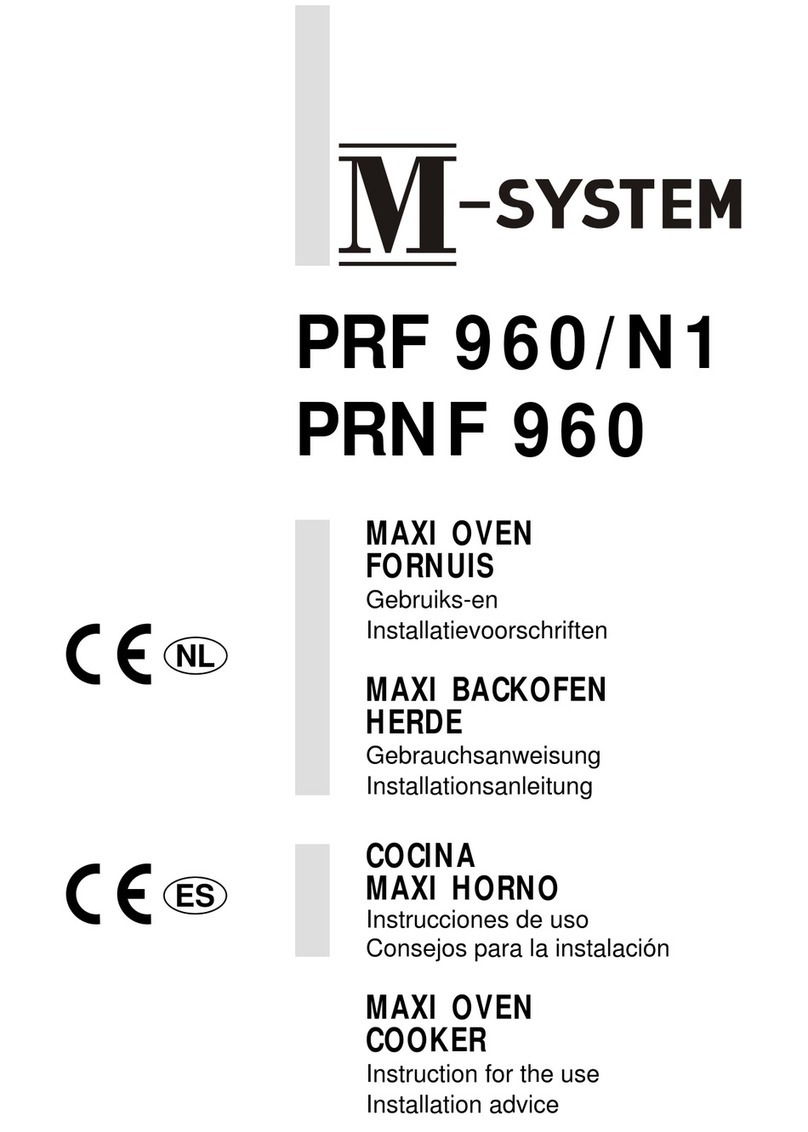
M-system
M-system PRF 960/N1 Installation and operating instructions
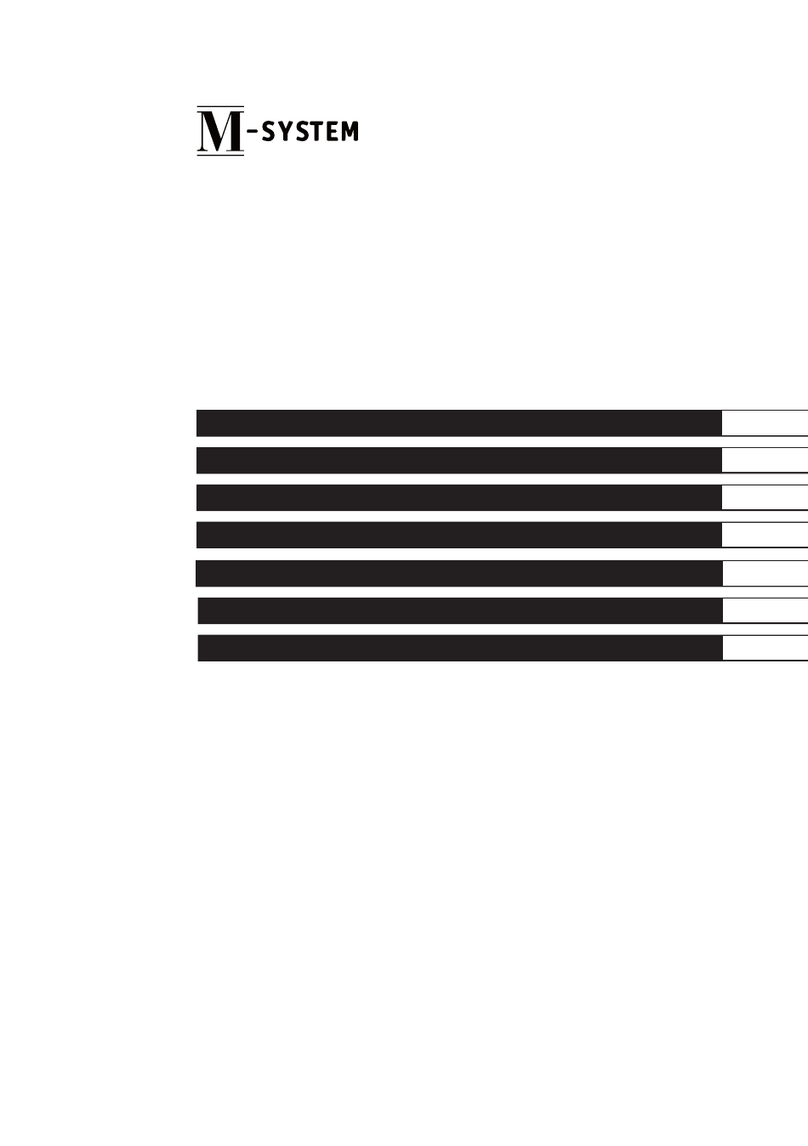
M-system
M-system MIO 640 User manual

M-system
M-system FD 96 Installation and operating instructions
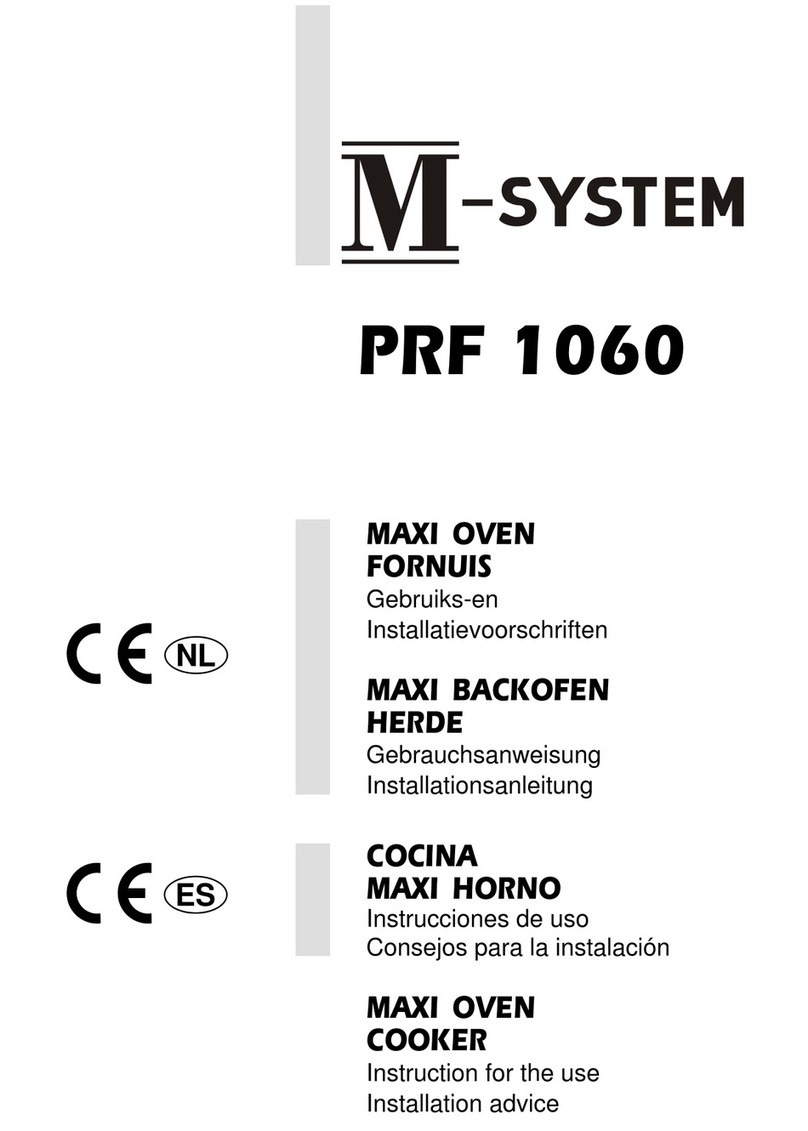
M-system
M-system PRF 1060 Installation and operating instructions
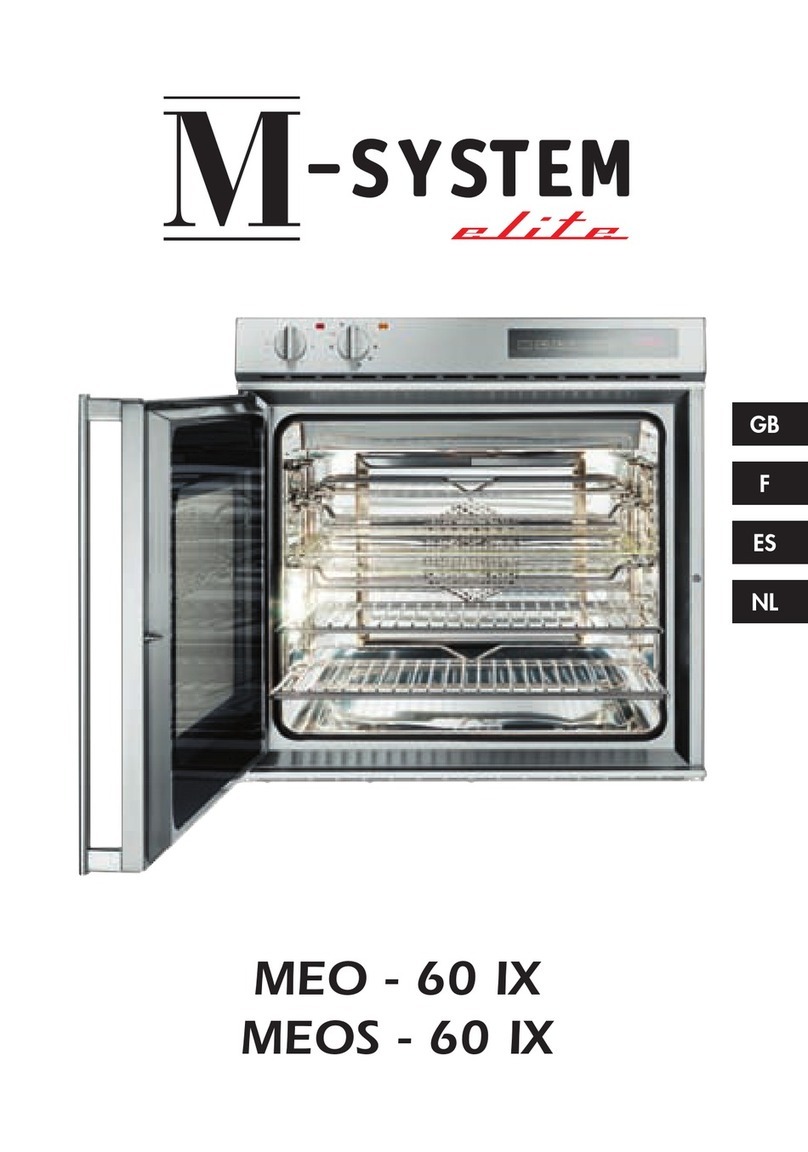
M-system
M-system Elite MEO-60 IX User manual




